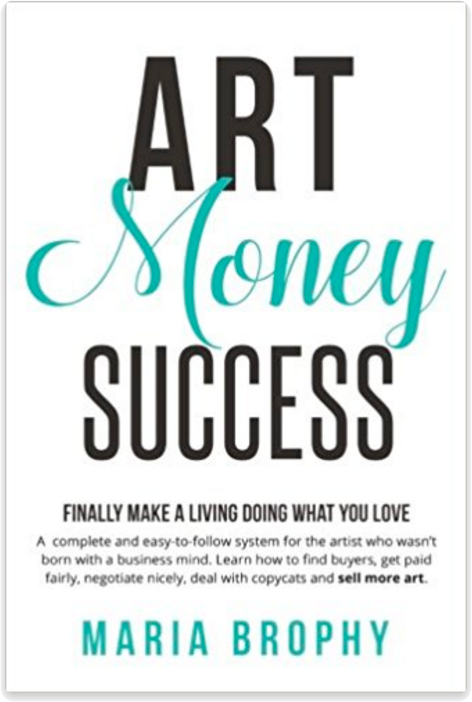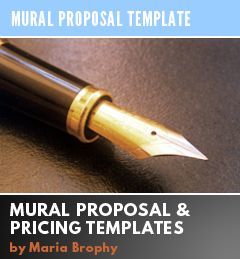 (This is a follow up to a post titled “The Artists Pain: Quoting and Negotiating Prices (A.K.A. the “BRO Deal”)”
(This is a follow up to a post titled “The Artists Pain: Quoting and Negotiating Prices (A.K.A. the “BRO Deal”)”
It’s a funny phenomenon that many visual artists share; the fear of giving a price quote.
They worry that if their price is too high, it will scare the client away. If it’s too low, then they’ll lose money.
And when put on the spot to pull a price out of thin air, they can screw it up.
It goes like this: a potential client asks you to create something you’ve never done before. And because you haven’t had experience with this particular item, you aren’t sure of the cost of materials, the time it will take, and the possible challenges that go with it. But you’re glad for the opportunity. And right on the spot the client eagerly asks “what is it going to cost me?”
You haven’t had time to consider price, but in your excitement, you blurt one out anyway. “Oh, it’ll only cost you about $2,000.00.”
That was a big mistake, because now that you’ve put a number in their head, they’ll hold you to it. And once you start crunching the numbers on what your actual costs will be, you realize that you underpriced it by about 50%. Ouch!
I’m speaking from experience here. I’ve underpriced a few more jobs than I care to admit. And it hurts when I do that. Under-pricing your work creates a litany of problems:
1.) The most obvious is that you don’t make money off the deal
2.) You’ve set a standard now for work priced lower than it should be
3.) You don’t give yourself the ability to provide the highest possible service – you’ll have to cut corners to get the job done (which doesn’t reflect well on you or make your client wildly happy)
Here’s a solution that helps keep you in line with giving a proper price quote:
FIRST: Tell the client asking for the price quote “I’ll have to crunch some numbers and e-mail you a quote. Let’s follow up tomorrow.” Never give a price on the spot unless you’ve done this before and you already know how to quote it.
SECOND: Take your time properly assessing the time, materials, and other costs involved with the project. Come up with a price fair to the client, and one that will produce a profit for you.
THIRD: Put together a Deal Memo or Proposal.
I use deal memos or proposals for everything, including mural paintings, one-time use fees, commissioned paintings and speaking engagements. I sleep better at night knowing that everything is in writing, thus avoiding misunderstandings later.
THE DIFFERENCE BETWEEN A DEAL MEMO AND A PROPOSAL:
A proposal is a glorified deal memo – it gives great detail on the project and can be multiple pages long.
A deal memo is more of an outline of the deal you are offering or quoting. It’s great to use before you put a lot of time into writing up a multiple page proposal – it will help to quickly determine if you and your client are on the same page with regards to pricing and the deal.
MORE ON THE DEAL MEMO: I started using deal memos years ago when we got into licensing. In the licensing industry, deal memos are used in the beginning stages of every business relationship.
A deal memo is a simple, one-page sheet that describes the deal you are offering. This sheet is meant to e-mail or hand to a client. Use of a proper deal memo assures your client that you are a professional and they come to understand that your price is your price.
The most important points outlined on a deal memo are:
- The name of the client
- A date that the offer expires (I use 30 days)
- A brief description of the project, event or painting
- Price and price options they can choose from
- Payment terms (I require 50% down & balance at completion)
- The deadline
- Copyright notice (we always state that the artist retains copyright)
A deal memo is not a contract or a legal agreement. It is simply a tool that you can use to provide a price quote while outlining the particular points that you want to agree on. Your client can look it over and accept or ask to make changes to the deal.
Sometimes, a deal memo will be the document used prior to the formation of a formal contract. But, it doesn’t have to be. The main idea here is to make sure that your client agrees to your pricing, terms and conditions.
Below is a sample Deal Memo that we’ve used in the past. I hope this is helpful to you, and please, forward onto your friends that may find this useful, too.
Maria xxoo
_________________________________________________________________________________________
DREW BROPHY DEAL MEMO
For Salong Restaurant, Fort McCoy, Florida (Client)
DATE: May 6, 2009 Offer Expires 30 days from date of Deal Memo
Project: Drew Brophy will paint a 36’ x 15’ wall mural depicting ocean scene. Artwork will begin and finish in a 10 day window.
Materials: Client is responsible to pay for materials
Cost: $16,000 plus travel expenses for Artist
Payment: 50% deposit required to schedule the painting. Balance is due on the day of completion.
Rights Granted: Client may use image for all marketing and advertising materials for ten (10) years.
Copyright: Is retained by Artist. The Copyright Notice: “Artwork © Drew Brophy” must be printed legibly on all print material.
Agreed to by:
For the Artist: ________________ For the Client: _______________
Add signature lines and date lines here
_________________________________________________________________________________________
Was this post helpful to you? Please, SUBSCRIBE to my e-mail newsletter. You’ll get my posts in your in-box and you won’t miss anything!















45 Responses
Brilliant–we’re going to start using deal memos right away for commissioned pieces!
We are strict about using proposals but I’ve never heard of a deal memo. I like it. The main reason we are so strict about proposals is to be very clear about the scope of work we are going to perform. Many clients like to blur those lines and try to get away with getting work for free. This way it’s all out in the open and they feel that they are getting what they paid for.
Yeah, Eric, I agree that lines can be blurred and work can take longer than expected, and if that happens, it’s easier if it’s in writing that you’ll charge more for different scenarios…..proposals are great for detailing all that stuff out (like how many sketches are provided for changes before additional sketch fees are incurred, etc.)
Thanks for reading my blog and commenting!
Wow, I’ve been emailing clients a “Deal Memo” for a long time, didn’t know there was a name for it. I put at the bottom of my email signature line how long the quote is valid.
Great tool and thanks so much for sharing a sample Maria!
I have an Architectural Design Office… (because I couldnt make money on Art alone) This would help prior to my official “proposal” in that field as well. If I keep reading your tips…. I might be able to add a division to “Shoreline Designs Inc” for just my Art.
Please comment on a stand alone co. vs. a division of an existing co. that targets a different market
Hey Rick, thanks for the comment and for reading my blog! Are you asking if you should make a new division to your company for your artwork, or should you keep it separate? If that’s you question, I would make it a division, so that you can capitalize off of your existing good name and possibly your existing customers with your art. Also, you’ll probably fare better with taxes and other financial considerations.
great advice- thanks for sharing… It’s always good to have things in writing to avoid any confusion or missunderstandings!
A “friend” on Facebook recommended your newsletter. I’m SO grateful. I have subscribed to a number of on-line art business news letters. Yours is definitely the best resource for me. You present information that is clear, concise, and realistic. Your articles cover the nitty gritty, less-than-exciting parts of running a fine arts business, with topics not covered elsewhere. Consider me your biggest new fan!
Thank you so much for writing those kind words! I’m flattered, and I appreciate it. If you have any topics you’d like me to cover, or a specific question or problem to solve, let me know and I’ll try to write a post on it!
the question ” was this helpful”? answer HELL YEA!
my art is finally strating to take off and get alot of notice from the right people, Im getting all kinds of inquiries from commissions to licensing.
Being at this level is all brand spankin new for me and im the kind of person who needs to gather lots of information before I committ to something so I know what I’m dealing with.
Everytime a new quesation comes up I come here, dig around a little, and find the perfect answer.
Someone else commented in another post ” Its like you’re giving away the secret to a magic trick”. I’ve asked countless artist for information and advice and everyone acts like its a big insider secret.. 9 times out of 10 I dont even get a reply.
Once again Maria comes though with the perfect solution to my current question. If I ever get the chance to meet you in person I’m giving you a big hug!
help…just got an inquiry from boss re a tropical mural (outdoors). 10×20 or 30 about 15 ft tall. We’ve never done an outdoor mural much less one that big. We are sorta new at this and not sure what to charge. What is a reasonable fee? This is scary for me. As you saY…dont want to overcharge and dont want to undercharge.. Dont have any other infor re surface, etc right now.
Thanks sooo much for all the info you are sharing and all the tips. We are definitely gonna create our own price list…so much less pressure that way!!!
Dear Maria,
Thanks for your comment and your question. Go to this post that I wrote with details on how to price a wall mural: https://mariabrophy.com/business-of-art/how-to-price-a-wall-mural-developing-a-price-sheet-and-proposal.html
Be sure to include in the proposal wording that gives you extra $ per hour should there be unexpected issues with the surface – this could be a problem if you don’t give yourself wiggle room on the pricing should the surface require more work than planned.
I hope this is helpful – good luck!
Me and my lady are just starting out in the commissioned art world and would like to thank you for sharing your experience with us. Your posts are very inspiring, well written, and I often reread some of your articles when I get discouraged. Also your husband’s artwork is very good and he has a very distinctive style. Keep up the great work.
Maria,
Great post, once again. I just shared this with a friend who has started doing designs for a T-shirt company. I can see using this for my fine-art painting commissions. Thanks for being an art advocate.
Thanks for that all the great tips. I subscribed to your email and to your twitter feeds. I often re-post your blog posts for my students, as I find arts educations to often be lacking on practical real world advice on how to make a money from (ie. a living!) in the arts.
A gentlemen asked in your response above how to deal with licensing art as a subset of his architectural company. You suggested he create a division of his company as a way to capitilize on his exhisiting reputation.
What would you suggest for artist that works in several mediums and styles? You talk about creating a recognizable visual identity, ie. brand with your artwork. But how to reconcile and present multiple identities? Perhaps you could do a blog post on this?
To use myself as an example I am currently working to realign my licensing web site: http://erinbrandberg.com with my fine art photography web site: http://erinsparler.com. We are changing the title, colors and format of the site, so that they will be similar and recognizable as the same individual. But how to align such completely different styles of work? Any suggestions on this topic?
Thanx God!! I’ve bumped into this page… So helpful..thank you sooo very much!!!
hi Maria thank you thank you thank you. so well explained.
Dear Maria,
I’d love to get work as a mural painter. Other than a love of painting and a general need for money while I’m in college, I’d love to cheer up my hometown with some nifty artwork, but I don’t really know how to get started. Do you have any advice on how to drum up business? And do you plan to post an outline of the process of working with outdoor paints? I’d hate to leave my customers with a mural that quickly fades and peels because I didn’t use the right materials.
Thanks in advance,
Melissa
Melissa, thanks for the comment. To drum up business in your town, start at City Hall – most cities have money put aside for projects like art and murals, and often they pay quite well. Start there and see what’s possible!
On the subject of pricing especially ones art when it comes to something we artist have not done before. I had this situation for making a miniature racing car. We talked about how nice it would be and all that was getting so exciting until that little alarm bell went off in my head say let this lady know that I am not doing this for no hobby or something.
So after asking for details like measurements and the like I came right out and asked her what would you feel to be a fair price to charge you for making this miniature racing car and her response was whatever I felt was right.
So after some talk about the project she said she would get back to me and I never heard from her since about doing any work on that miniature racing car.
So I guess the moral of that story was “That there never was a car to be made in the first place” Bring up the subject of money I believe me this will give any person the notion that I am a freebie is off the table. I take my work very seriously and I am no freebie or believe in pricing my work as a lost leader unless I absolutely a need too.
Kenneth C Young
Thank you SO much for the info! I was wondering how you accept payments, do you set it up online with pay pal or have them mail checks, etc.?
Rachel, we take MC/Visa, Paypal and checks. But, if they pay by check, we have to wait for it to clear before starting the project (usually just a few days).
As to this statement They worry that if their price is too high, it will scare the client away. If it’s too low, then they’ll lose money.
I do not know why we have to be worrying about whether the price is to low or too high. Set your price with an hourly wage in it and leave it at that.
We are artist and just as important as the Mechanic,electrician ETC. You go to get work done on your car and if you ask for a reduction in the hourly rate do you think you will get it I think not.
I set my art at a price that has an hourly rate and cost of material and the price is set with no reductions in price. In my opinion when you reduce your price then you might just as well tell your customer that your work is not worth the price.
Kenneth
Thank you for this article. I’ve adopted using the Deal Memo with great success, closing the deal for my performances on many occasions. Cheers,
Gabriello
Well on the subject of “The Fear Factor” when it comes to pricing your work well I have a good answer for that and that is “Don’t Be Fearful”
You are an artist just like the Mechanic down the road and you are also providing a service. Set your hourly rate to what you know what you are worth and stick the hell to it.
I just received an order to make a Black berry holder and I simply told the guy that sir I will tell you upfront I charge $25.00 an hour,plus material and electrical usage expenses. I said if this is agreeable to you then we can proceed. He said go ahead and make the black berry holder.
We artist have to take the attitude that we provide a valuable service to our communities and we are worth every penny that we charge. One word of advice do not flip flop on your hourly wages. When you go to get winter or summer tires put on your car does the Mechanic shop owner flip flop on the set price or hourly rate for this job… no he/she will not so why should we artist.
I look at it this way if I have to start dropping my price on what my hourly rate is and other expenses then I might just as well go and get a crummy pay per hour job.
Kenneth C Young
Recently an agent sent me a long form ( worldwide exclusive) contract that I could not sign. We had already begun negotiations with a Canadian Company for 6 artwork titles and he then sent a Deal Memo. I am concerned about the small print and details lacking in this document and need to know how to protect my interests since he has stated that he is no longer going to represent my portfolio. How should I protect myself?
John, a few thoughts on your question:
1 – it’s rare to find an agent that works WORLDWIDE. Agents work by territory – for example, America, or U.K., or Europe. We have an agent that covers Australia, New Zealand and the South Pacific. And then we have another one that covers Brazil only. It’s impossible for an agent to be worldwide. So I would insist on the agent/artist contract only covering the area in which the agent actually works.
2 – The Agent/Artist contract should have a short term (i.e. one year) so that you can make sure that it’s going to work out for you both. If it’s going well, you can renew for a longer term after the one year.
3 – The agent cannot negotiate on your behalf without an Artist/Agent contract. They should nail down their contract with you before they offer your art to any company (including this Canadian co)
4 – Don’t sign anything you don’t agree with. Keep in mind that everything is negotiable. Most companies will make changes to contracts when asked to, as long as it’s reasonable.
There’s a lot more to this story than I can get in a blog comment. If you want to set up a consulting call with me, I think I can help. These types of things are my specialty! Email me at consulting@mariabrophy.com.
Deal memo would have saved me a lot of time and material. A “friend” who had been at a gallery showing of my art commissioned a 4’x5′ WC, framed, etc. He saw prices, etc. When painting finished and I gave him the price (befor he saw it), he gave me the sad song. He is “well blessed” with finances but I realized that he expected me to paint it for him as a “freeby” and pay only for framing, which I discovered thru a statement on the phone. Moral of the story, contract, invoice befor starting as your blog stats. Thanks for all the info you post.
Hello could use please send me all the information on deal demos…Thank you very much…
Free Printer Free Cartridge
Just Call-8689876786
The sample Deal Memo included:
“Rights Granted: Client may use image for all marketing and advertising materials for ten (10) years.”
I would have also added “No transfer of rights.
I so agree with #2 however in a small town with low income an artist can get themselves in the catch of Be Dammed If You Do And Dammed If You Don’t.
If a person goes by setting ones hourly time and materials into the Artpiece they may be overpricing to what that person can afford and on the other hand if the Artist sets the price to a much lower price to suit the buyers affordability then that would be setting the standard of price for the Artists work.
Hi Maria,
Thank you very much for the nice sharing articles! Great blog!
Here’s the case : At beginning I was approached for creat one illustration used on a mini-collection of packagings (5 makeup items) will be a regional sell. So I gave a quote (flat fee including the ads and packaging license fee ) without Royalty %… After 3 months, they returned with the Go for this project, but the characteristics are changed to bigger : instead 5 items, it will be still one illustration, but for using on 15 different Xmas boxes (makeup + fragrance + skincare) and on all ads materials, (and they want to able to change colors by their interim graphic designer), the territory will be international.
In this case, is it bad to change my quote by adding a royalty % cost on top of the flat fee I gave?
Thank you !
Ben
Hi Ben,
You could either ask for royalties, or, increase your price accordingly. The first quote you gave was based on one thing, and now they have expanded the scope of use. So, your pricing should be increased as well.
Asking for royalties works if it’s a company that commonly pays royalties. But if not, it could be more of a hassle for you and them.
Increasing your fee might make more sense.
But, the answer depends on so many factors, my answer is based on the limited info I have about the deal.